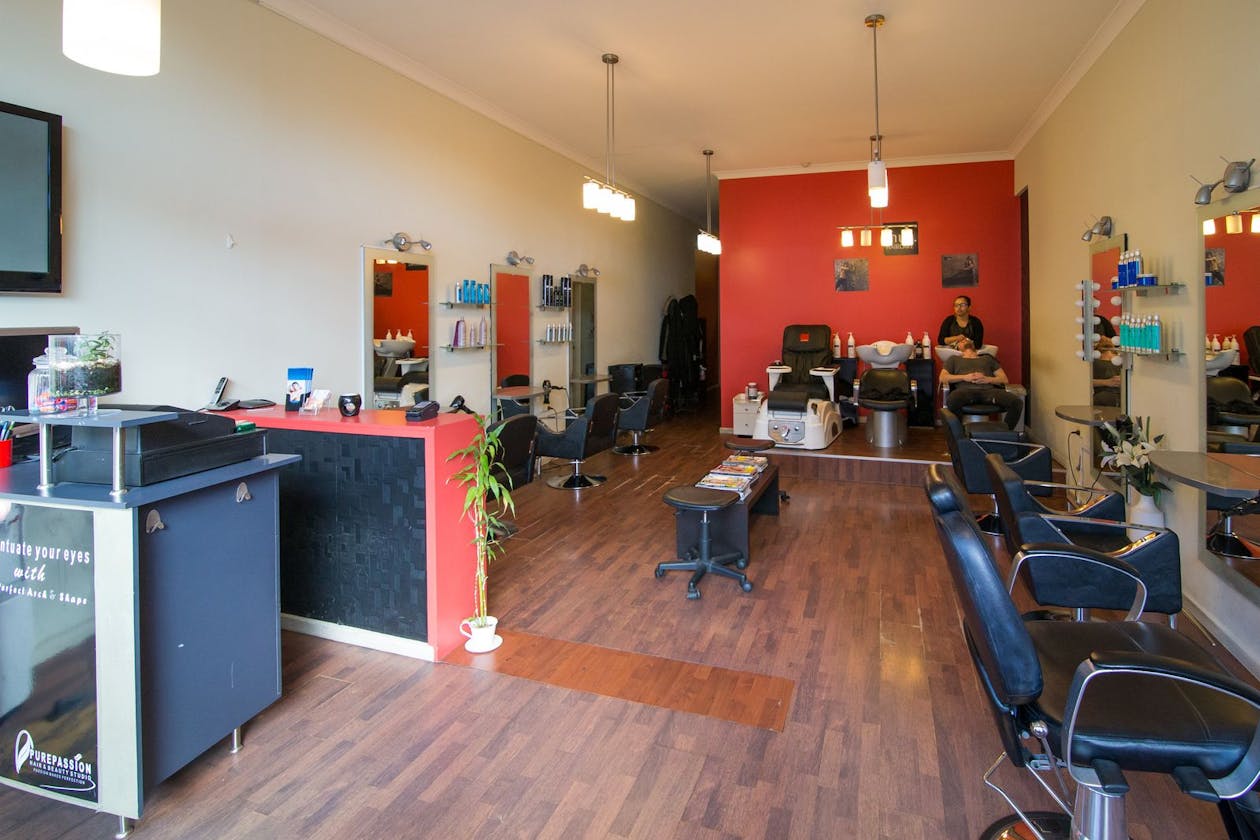
Hair Loss Treatment Book your hair loss treatment appointment online and save
Top 20 Hair Loss ClinicsFor more salons, check out Fresha’s list of Hair Salons.
 Shop 3/20 Howard Road, Padstow 2211(162)Revive Beauty Clinic offers the ultimate in luxurious beauty treatments; skin needling, ultrasound fat cavitation and pro whitening teeth treatments.
Shop 3/20 Howard Road, Padstow 2211(162)Revive Beauty Clinic offers the ultimate in luxurious beauty treatments; skin needling, ultrasound fat cavitation and pro whitening teeth treatments.
Pure Passion Hair and Beauty
89 Anderson Street, Yarraville 3013(160)Get all your hair and beauty needs covered in one place with Pure Passion Hair and Beauty. Services include hair, skin, nail and eyebrow threading.
Razouk Hair Collection
Shop 2 / 79 Phillip Street, Parramatta 2150(30)Razouk Hair Collection offers the latest trends in haircutting and colouring, plus an amazing range of hair treatments, such as Hair "Botox".
Hairlogica
292 St Kilda Rd, St Kilda 3182
ELKA Clinic
3/29 Hood street, Subiaco, 6008, Western Australia, Subiaco 6008Elka Brows specialises in Eyebrow Tattooing Microblading and Feathering, and Scalp Micro Pigmentation. The result is natural, long lasting and beautiful.
Sandton Hair Gallery
541B Whitehorse Road, Mitcham 3132Sandton Hair Gallery is a long-standing hair salon in Mitcham. Known for its quality service and ecofriendly approach, you and the environment will be in love with the end result.
Salon Shique
41 Ralston Street, South Yarra 3141
Man Cave Sydney
Shop 7 5 Hunter Street, Sydney CBD 2000
Queen Street Beauty and Hair
Shop 2, 128 Queen Street, Woollahra 2025(3)Queen Street Beauty & Hair is a beautiful boutique salon. They're passionate in hair, anti-aging facials, lash tinting, manicures, and soothing massages.
Angela's Mane Attraction
196 High Street, Kew 3101(1)Angela's Mane Attraction, a cutting edge hairdressing salon, which also specialises in other beauty services such as waxing and nails.
BigStar Hair and Beauty Sunshine
Shop 37 / 80 Harvester Road, Sunshine 3020BigStar Hair and Beauty Sunshine is a Sunshine hair and beauty salon offering tailored hair services in a specialist salon environment.
AESTHETIC SKINCARE SOLUTIONS
9A Salisbury Avenue, Blackburn 3130Aesthetic Skincare Solutions offers procedures to improve your skin, including micro/hydro dermabrasion, clinical peels, dermaplaning and LED phototherapy.
ZenSkin Studio
29 Puckle St, Moonee Ponds 3039(1)ZenSkin Studio is a premium beauty studio providing cosmetic services of exceptional quality and variety in Moonee Ponds.
Tango Hair Loss Clinic
135 Waterworks Rd, Ashgrove 4060
Liz Plummer Cancer Care Centre
249-251 Lake St, Cairns North 4870
Lucy Lane Beauty Therapy
21 Albar St, Wavell Heights 4012
Hair By Science
19/29 Martin Pl, Sydney 2000
Hair X
5/771 Beaufort St, Mount Lawley 6050
Kiss Health & Beauty
4/49 Church Ave, Armadale 6112
THE LABODYTORY
5 Bishop St, Morley 6062
Hair Loss Treatment
Hair loss is very distressing and it's not just limited to men. It can occur as a natural part of the ageing process or be due to illness, trauma, medication and genetics. Sadly hair loss can have a dramatic impact on a person's self-confidence.
Androgenetic alopecia - or male pattern hair loss - happens to pretty much all men to some degree. Hair loss generally begins at the temples before the hairline gradually recedes. Significant hair loss affects about 20% - or one in five - of Australian men in their 20s. That figure may surprise you.
By their 30s about 30% of Australian men experience significant hair loss. This figure increases to 40% in their 40s.
Natural Hair Loss
It's important to put this in context. Most people naturally shed up to 150 hairs a day. It's just part of the hair growth cycle. This should not be confused with significant hair loss.
Female hair loss is much more common than you may think. In fact, if you are a mum, you may well have experienced some hair loss during pregnancy. It is estimated that more than 50% of women will experience some degree of hair loss during their lifetime.
Historically there were practically no solutions to hair loss, apart from wearing a wig. Lucky for us, there is now a good choice of hair loss treatment on the market. These range from natural therapies to hair transplants.
One word of warning: the internet is full of so-called miracle cures - very few are actually proven to get results. It is far better to go to a hair loss specialist.
Here are some popular Hair loss treatments:
Finasteride
Finasteride is a prescription medicine shown to prevent or slow down hair loss. It works by blocking an enzyme called 5-alpha reductase that converts testosterone to dihydrotestosterone (DHT). DHT causes hair follicles to shrink. Side effects are uncommon but you may need to take the drug for at least a year to be effective.
Saw Palmetto
For a herbal alternative to finasteride, you may like to try Saw Palmetto. Like finasteride, it is actually prescribed to treat an enlarged prostate but is also believed to help prevent hair loss.
Minoxidil
Minoxidil is a topical treatment which should be applied to the scalp twice daily. It works best for people with recent or mild hair loss. It may take up to a year to see results and hair loss is likely to restart when you stop the medication.
Hair Transplants
Major advancements have been made in hair transplant surgery and it is now more readily available and more affordable. The procedure is usually done by removing a strip of scalp from the side or back of the head, separating the follicles and inserting them into the crown and temples.
Despite its increased availability, this is still quite an expensive option. It is essential to discuss this option with a professional.
Laser Therapy
Low-level laser therapy may also be an option for treating hair loss. The treatment may be combined with a course of minoxidil and finasteride, special shampoos and thickening conditioners.
Hairpieces
Now far more efficient and natural-looking, hairpieces (wig or toupee) are an affordable alternative to hair loss treatments. They are excellent for covering a large area of thin or lost hair. Carefully matched to your own hair colour and texture, they can be undetectable to most people, even at the hairline.
There is ongoing maintenance, including cutting your natural hair and cleaning the hairpiece. Hairpieces last from six months to two years before needing replacement. For many people, it works out more cost effective to consider hair transplant surgery.
Find hair loss specialists in your locality by searching Bookwell.
Book Hair Loss Treatment in your city
- Adelaide
- Ballarat
- Bathurst
- Brisbane
- Bunbury
- Cairns
- Canberra
- Central Coast
- Coffs Harbour
- Darwin
- Geelong
- Gippsland
- Gladstone
- Gold Coast
- Goulburn
- Hobart
- Launceston
- Mackay
- Melbourne
- Mornington Peninsula
- Mount Gambier
- Newcastle
- Northern NSW
- Perth
- Regional NSW
- Regional QLD
- Shepparton
- Sunshine Coast
- Sydney
- Toowoomba
- Torquay
- Townsville
- Warrnambool
- Warwick
- Wollongong